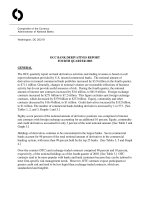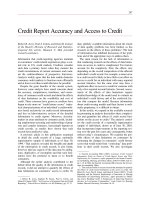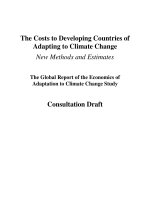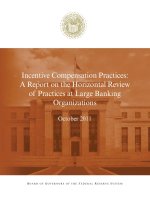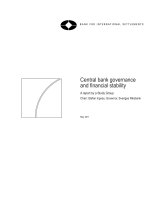MCB internship report
Bạn đang xem bản rút gọn của tài liệu. Xem và tải ngay bản đầy đủ của tài liệu tại đây (1.39 MB, 151 trang )
INTERNSHIP REPORT ON MCB BANK LIMITED
INTRODUCTION
The word 'Bank' is said to have been derived from the words
Bancus or Banque or Bank. This history of banking is traced to as
early as 2000 B.C. The priests in Greece used to keep money and
valuables of the people in temples. These priests thus acted as
financial agents. The origin of banking is also traced to early
goldsmiths. They used to keep strong safes for storing the money
and valuables of the people. The persons who had surplus money
found it safe and convenient of deposit their valuables with them.
The first stage in the development of modern banking, thus, was
the accepting of deposits of cash from those persons who had
surplus money with them.
The goldsmiths used to issue receipts for the money deposited
with them. These receipts began to pass from hand to hand in
settlement of transactions because people had confidence in the
integrity and solvency of goldsmiths. When it was found that
these receipts were fully accepted in payment of debts; then the
receipts were drawn in such a way that it entitled any holder to
claim the specified amount of money from goldsmiths. A
depositor who is to make the payments may now get the money in
cash from goldsmiths or pay over the receipt to the creditor.
These receipts were the earlier bank notes. The second stage in
the development of banking thus was the issue of bank notes.
University of the Punjab, Gujranwala Campus
1
INTERNSHIP REPORT ON MCB BANK LIMITED
The goldsmiths soon discovered that all the people who had
deposited money with them do not come to withdraw their funds
in cash. They found that only a few persons presented the
receipts for encashment during a given period of time. They also
found that most of the money deposited with them was lying idle.
At the same time; they found that they were being constantly
requested for loan on good security. They thought it profitable to
lend at least some of the money deposited with them to the
needy persons. This proved quite a profitable business for the_
goldsmiths. They instead of charging safe keeping charges from
the depositors began to give them interest on the money
deposited with them. This was the third stage in the development
of banking.
University of the Punjab, Gujranwala Campus
2
INTERNSHIP REPORT ON MCB BANK LIMITED
DEFINITION OF BANK
The term 'bank' is being used for a long time, yet it has no
precise definition. The basic reason is that the commercial banks
perform not just one but many types of functions. The term bank
has been defined differently by different authors. Some are as
follows:
According to Crowther,
"Bank is a dealer in debts—his own and of other people."
According to G.W. Gilbert,
"A banker is a dealer in capital or more properly a dealer in
money. He is an intermediate party between the borrower and the
lender. He borrows from one party and lends to another."
According To Bamkinh Companies Ordinance
U/s3 (B) of Banking Companies Ordinance 1962 "Banker means
person transacting the business of accepting for the purpose of
lending or investment, of deposits of money from the public,
repayable on demand or otherwise and withdraw able by cheque,
draft, order or otherwise and includes any Post Office Savings
Bank."
University of the Punjab, Gujranwala Campus
3
INTERNSHIP REPORT ON MCB BANK LIMITED
HISTORY OF BANKING IN PAKISTAN
The interesting point which I observed during the span of mine
internship was the historical background of Banking & Financial
sector which is the one in which great improvement and growth is
observed since the formation of Pakistan. For studying the
growth of this sector we can divide it into three stages, which
are as follows
a) Pre-Nationalization Era
b) Nationalization Era
c) Post Nationalization Era
A) Pre Nationalization Era
There were only two Muslim banks in Indo Pak before partition,
they were;
Habib Bank Ltd. (estd. in 1941 at Bombay) & Australia Bank Ltd.
(estd. In 1944 at Lahore). Hindus or Foreigners either owned all
other banks, at that time.
At the time of partition there were 631 bank branches in area,
which came under Pakistani control. But due to blood shed and
violence at large scale, mostly branches were closed and the
disparity can be assessed from the fact that on July 1948 there
University of the Punjab, Gujranwala Campus
4
INTERNSHIP REPORT ON MCB BANK LIMITED
were 195 branches with deposits of Rs.88 crore (880 million) only.
Also a factor lagging in Pakistani industry was a central bank of
its own, by that time Reserve Bank of India was acting as central
bank for both countries and same currency notes were used in
both territories. But Reserve Bank of India was biased and Set
down Pakistan on many occasions such as the issue of funds
transfer etc.
In this period drastic steps were taken in government sector for
the improvement of overall position. The private sector also
responded to these changes and some very positive changes were
observed. Some of the steps taken by the government in this
regard were as under:
i. Inauguration of State Bank of Pakistan (SBP) on 1st July,
1948.
ii. Setting up of National Bank of Pakistan in November, 1949
to control the 'jute' export in East Pakistan and to act as
agent of SBP.
iii. Larger powers were given to SBP through SBP Act (1956)
for controlling purposes.
iv. Banking Companies Ordinance 1962 for protection and
guidance to banks.
v. Establishment of specialized banks, such as ADBP (1952);
a) HBFC (Nov, 1952);
b) P1CIC (Oct, 1957)
c) IDBP (Aug. 1961);
d) NDFC (Jan, 1973).
University of the Punjab, Gujranwala Campus
5
INTERNSHIP REPORT ON MCB BANK LIMITED
These were the steps, which built a strong banking sector in
Pakistan. This is also obvious from the facts that by 1973 there
were almost 10 foreign banks were working in Pakistan and all
over deposit position was around Rs.2300 crore (23,000 million).
A bird eye view of 5 top banks was as given below:
BANKING SECTOR IN PAKISTAN IN 1973
BANK NO.OF BRANCHES DEPOSITS
Habib Bank Ltd. 667 Rs. 6,160 (million)
National bank of
Pakistan Ltd.
579 Rs. 5,660 (million)
United Bank Ltd 497 Rs. 5,670 (million)
MCB Bank Ltd. 506 Rs. 1,640 (million)
Allied Bank Ltd. 145 Rs. 570 (million)
University of the Punjab, Gujranwala Campus
6
INTERNSHIP REPORT ON MCB BANK LIMITED
B) Nationalization Era:
On January 01, 1974 all Pakistani banks were nationalized through
Nationalization Act 1974. Under this law all Pakistani banks
became a public property. All small banks were merged in bigger
banks to create 5 major Pakistani banks Pakistani banks. These
banks were to control by Pakistan Banking Council. There are still
controversies about this act of government as whether it
contributed in success of failure of banks. However the major
changes after nationalization were as follows:
Working of banks was extended to under developed
areas.
Market expansion for credit and deposits.
Bank were encouraged to extend cooperation to
neglected areas
Decrease in service level of bank officers.
Decrease in profitability as well.
University of the Punjab, Gujranwala Campus
7
INTERNSHIP REPORT ON MCB BANK LIMITED
C) POST NATIONALIZATION ERA
In 1990 the government decided to denationalize all the
nationalized institutes. Some was also suggested in banking
sector. For this purpose, amendments were made to
Nationalization Act 1974 and two nationalized banks were
privatized. Along with this a permission to open banks in private
sector was also granted. The rules regarding establishment of
new banks and for incoming foreign banks were also relaxed.
The-three privatized banks are;
a) MCB taken up by a private group in April, 1991
b) ABL taken up by its own employees in September 1991.
c) UBL taken up by UAE party in 2002.
After these changes a large number of private and foreign banks
started their operations in Pakistan and the present status can
be seen from the following figures:
SCHEDULED BANKS
Category No. Of Banks
Nationalized Commercial Banks 3
Private / Privatized Commerce Banks 18
Public Sector Specialized Banks 4
Foreign Banks 19
Total Schedule Banks 44
University of the Punjab, Gujranwala Campus
8
INTERNSHIP REPORT ON MCB BANK LIMITED
In addition to above mentioned scheduled banks there are 11
Development Financial Institutes (DFI’s), 16 Investment Banks
and 21 leasing and Modarbah Companies.
PAKISTAN BANKING SECTOR
• Nationalized Commercial Banks
• Privatized Banks
• Specialized banks
• Private banks
• Foreign banks
• Other financial Institutions
NATIONALIZED SCHEDULE BANKS
• First Women Bank Ltd.
• National Bank of Pakistan
• Habib Bank Ltd.
DE-NATIONALIZED SCHEDULE BANKS
• Allied Bank of Pakistan Limited
• MCB Bank Limited
• United Bank Ltd.
University of the Punjab, Gujranwala Campus
9
INTERNSHIP REPORT ON MCB BANK LIMITED
SPECIALIZED BANKS
• Zarai Taraqiti Bank of Pakistan (ADBP)
• Industrial Development Bank of Pakistan(IDBP)
• Punjab Provincial Cooperative Bank
• Federal bank for Cooperatives
PRIVATE SCHEDULE BANKS
• Askari Commercial Bank Ltd.
• Bank Alfalah Ltd.
• Bank Al-Habib Ltd.
• Bolan Bank Ltd.
• Faysal Bank Ltd.
• Habib Credit & Exchange Bank
• Indus Bank Ltd.
• Metropolitan Bank Ltd.
• Platinum Bank Ltd.
• Prime Commercial Bank Ltd.
• Prudential Bank Ltd.
• Soneri Bank Ltd.
• The Bank of Khyber
• The Bank of Punjab
• Union Bank Ltd.
University of the Punjab, Gujranwala Campus
10
INTERNSHIP REPORT ON MCB BANK LIMITED
FOREIGN BANKS
• ABN AMRO Bank N.V.
• Albaraka Islamic Bank BSC (EC)
• American Express Bank Ltd.
• ANZ Grindlays Bank Ltd.
• Bank of America (NT & SA)
• Bank of Tokyo Mitsubishi Ltd.
• Bank of Ceylon
• Banque Indosuez
• Citibank N.A.
• Credit Agricole A.G.
• Deutche Bank A.G.
• Doha Bank Ltd.
• Emirates bank International Ltd.
P.J.S.C.
• Habib Bank A.G. Zurich
• Hong Kong and Shangai Banking Crop. Ltd.
• International Finance Investment and Commerce Bank
Ltd.
• Mashreq Bank PSC
• Oman International Bank SOAG
• Rupali Bank Ltd.
• Societe Generale, the French Int. Bank Ltd.
• Standard Chartered Bank
• Trust Bank Ltd.
University of the Punjab, Gujranwala Campus
11
INTERNSHIP REPORT ON MCB BANK LIMITED
DEVELOPMENT FINANCIAL INSTITUTIONS (DFIS)
• Investment Corp of Pakistan
• National Development Finance Corp.
• Pakistan Industrial Credit and Investment Corp.
• Pak Kuwait Investment Company
• Pak Libya Holding Company
• Regional Development Finance Corp.
• Saudi Pak Industrial & Agricultural Investment
Corporation
• Small Business Finance Corporation
• House Building Finance Corporation
• National Investment Trust
INVESTMENT BANKS
• Crescent Investment Bank
• First International Investment Bank
• Atlas BOT Investment Bank
• Security Investment Bank
• Fidelity Investment Bank
• Prudential Investment bank
• Islamic Investment Bank
• Asset Investment Bank
• Al-Towfeek Investment Bank
• Al-Faysal Investment Bank
University of the Punjab, Gujranwala Campus
12
INTERNSHIP REPORT ON MCB BANK LIMITED
• City Corporation Investment Bank (Pak) Ltd.
• Franklin Investment Bank Ltd.
• Orix Investment Bank (Pak) Ltd.
• Trust Investment Bank Ltd.
HISTORY OF THE MCB BANK LIMITED
Before separation of Indo Pak, the need for more Muslim banks
was felt. And Muslims having strong financial capacity were
thinking to invest in this sector as well. This was the idea which
paved the way for setting up MCB Bank Ltd known as MCB. This
was the third Muslim bank in the subcontinent.
HISTORY
This bank was incorporated under companies’ act 1913 on 9
th
July,
1947 (just before partition) at Calcutta. But due to changing
scenario of the region, the certificate of incorporation was
issued on 17
th
August, 1948 with a delay of almost 1 year; the
certificate was issued at Chitagong. The first Head office of the
company was established at Dacca and Mr. G.M. Adamjee was
appointed its first chairman. It was incorporated with an
authorized capital of Rs. 15 million.
After some time the registered office of the company was
shifted to Karachi on August 23rd, 1956 through a special
resolution, now recently the Head office of MCB has been
transferred to Islamabad in July, 1999 and now Head office is
termed as Principle Office.
University of the Punjab, Gujranwala Campus
13
INTERNSHIP REPORT ON MCB BANK LIMITED
This institute was nationalized with other on January 1st, 1974.
At that time it had 506 branches and deposits amounting to Rs.
1,640 million. Although. MCB has a reputation of a conservative
bank but nationalization also left its effects on this institute as
well and by end of year 1991 in which it was privatized the total
number of branches were 1.287 and deposits amounting to as high
as Rs. 35,029 million
PRIVATIZATION
When privatization policy was announced in 1990, MCB was the
first to be privatized upon recommendations of World Bank and
IMF. The reason for this choice was the better profitability
condition of the organization and less risky credit portfolio which
made'' it a good choice for investors. On April 8th, 1991, the
management control was handed over to
National Group
(the
highest bidders). Initially only 26% of shares were sold to private
sector at Rs. 56 per share.
AFTER PRIVATIZATION
Ten years after privatization, MCB is now in a consolidation stage
designed to lock in the gains made in recent years and prepare
the groundwork for future growth. The bank has restructured its
asset portfolio and rationalized the cost structure in order to
remain a low cost producer.
After privatization, the growth in every department of the bank
has been observed. Following are some key developments:
University of the Punjab, Gujranwala Campus
14
INTERNSHIP REPORT ON MCB BANK LIMITED
• Launching of different deposit schemes to increase saving
level.
• Increased participation on foreign trade.
• Betterment of branches and staff service level.
• Introduction of Rupee Traveler Cheques & Photo Credit
Card for the first time in Pakistan.
MCB BANK TODAY
MCB today, represents a bank that has grown with time,
experience and Pakistan. A major financial institution, in scope
and size, it symbolizes a fully growing tree evergreen, strong, and
firmly rooted.
FOREIGN TRADE
The bank conducted import business during the year amounting to
RS. 54.0 billion as compare to RS. 56.4 Billion In 2005. The
export business slightly improves to RS. 36.9 Billion From RS.
35.1 Billion. In 2006. Home remittances decline to RS. 16.7 Billion
From 30.7 Billion the decline in home remittances business was
due to freezing of Foreign Currency Accounts, which has
affected the confidence of Pakistanis working overseas
.
YEAR 2006 COMPLIANCE
University of the Punjab, Gujranwala Campus
15
INTERNSHIP REPORT ON MCB BANK LIMITED
MCB’s strength lies in providing a technological base at the gross
root level of the society with a challenge to educate and
assimilate such systems across vast cultural and economic
backgrounds. With over 768 automated branches, 263 online
branches, over 151 MCB ATMs in 27 cities nationwide and a
network of over 16 banks on the MNET ATM switch, MCB
continuously innovates new products and services that harness
technology for the customer’s benefits.
SOCIAL SECTOR
The bank activity participating in the Prime Minister self-
employment Scheme. The application received from various
applicants is being processed on merit and disposed off as quickly
as possible.
THE BUSINESS
MCB is in it’s over 50 years of operation. It has a network of
over 1,000 branches all over the country with business
establishments in Sri Lanka and Bahrain. The branch break-up
province wise is Punjab (57%), Sindh (21%), NWFP (19%) and
Blochistan (3%) respectively.
MCB has an edge over other local banks, as it was the first
privatized bank. The State Bank of Pakistan has restricted the
number of branches that can be opened by foreign banks, an
advantage that MCB capitalizes because of its extensive branch
network.
Fourteen years after privatization, MCB is now in a consolidation
stage designed to lock in the gains made in recent years and
University of the Punjab, Gujranwala Campus
16
INTERNSHIP REPORT ON MCB BANK LIMITED
prepare the groundwork for future growth. The bank has
restructured its asset portfolio and rationalized the cost
structure in order to remain a low cost producer.
MCB now focuses on three core businesses namely Corporate,
Commercial and Consumer Banking. Corporate clientele includes
public sector companies as well as large local and multi national
concerns. MCB is also catering to the growing middle class by
Providing new asset and liability products. The Bank provides 24
hour banking convenience with the largest ATM network in
Pakistan covering 27 cities with over 151 ATM locations. The
Bank’s Rupee Traveller Cheques have been market leaders for the
past six years and have recently launched their Gift Cheque
Scheme.
MCB looks with confidence at year 2007 and beyond, making
strides towards fulfillment of its mission, "to become the
preferred provider of quality financial services in the country
with profitability and responsibility and to be the best place to
work".
A major achievement of MCB is that the state bank of Pakistan
has issued a license to MCB to start Islamic banking. Now MCB is
setting up a 1
st
Islamic banking branch at 1
st
floor shaheen
complex, Karachi. This complex starts working from September 1,
2003.
University of the Punjab, Gujranwala Campus
17
INTERNSHIP REPORT ON MCB BANK LIMITED
Vision Statement
CHALLENGING AND CHANGING THE WAY YOU BANK
University of the Punjab, Gujranwala Campus
18
INTERNSHIP REPORT ON MCB BANK LIMITED
Mission Statement
To become the preferred provider
of quality financial services in our
country with the profitability and
responsibility and to be best place
to work
University of the Punjab, Gujranwala Campus
19
INTERNSHIP REPORT ON MCB BANK LIMITED
Our Core Values
CUSTOMER FOCUS
We treat each of our customer equality & as the most important
person while we interact with him/her. We must ensure that we
do everything to meet and exceed the customers expectations
with perfect to times, accuracy & quality services.
EMPLOYEE RESPECT & DIGNITY
We treat each of our employees with fairness, which includes
giving constructive feedback for their development. We
celebrate diversity and seek suggestions from all employees for
improvement. We ensure that responsibility & fairness in all our
decision-making.
TEAM BASED APPROACH
University of the Punjab, Gujranwala Campus
20
INTERNSHIP REPORT ON MCB BANK LIMITED
QUEST FOR QUALITY
We ensure that each moment of our time is spent on value adding
activity. We always seek ways for exceeding expectations of
customers & colleagues. We also ensure that we do things right,
first time every time.
GOOD CORPORATE CITIZENSHIP
We ensure that we contribute our due share to the Govt. we
realize that we have a responsibility to the society in which we
operate & we seek ways of playing a positive role for the
betterment of the community at large.
University of the Punjab, Gujranwala Campus
21
We work towards achievement of our vision & mission as a
combines group. We encourage inter & intra-
departmental communications. We treat our colleagues as
our internal customers & ensure that the requirements of
internal customer focus are always met.
INTERNSHIP REPORT ON MCB BANK LIMITED
Management Committee
University of the Punjab, Gujranwala Campus
22
INTERNSHIP REPORT ON MCB BANK LIMITED
Board of Directors
Mian Mohammad Mansha Chairman
S.M. Muneer Vice Chairman
Mohammad Aftab Manzoor President & Chief Executive
Tariq Rafi Director
University of the Punjab, Gujranwala Campus
23
INTERNSHIP REPORT ON MCB BANK LIMITED
Sheikh Mukhtar Ahmed Director
Mohammad Arshad Director
Shahzad Saleem Director
Mian Umer Mansha Director
Sarmad Amin Director
University of the Punjab, Gujranwala Campus
24
INTERNSHIP REPORT ON MCB BANK LIMITED
Audit Committee
Mian Mohammad Mansha Chairman
Shaikh Mukhtar Ahmed Member
Shahzad Saleem Member
Chief Financial Officer
Ali Amin
Company Secretary
Tameez-ul-haque
Auditor
A.F.Ferguson & co
Chartered accountants
M.Yousuf Adil Saleem & co
Chartered accountants
Legal Advisor
University of the Punjab, Gujranwala Campus
25

